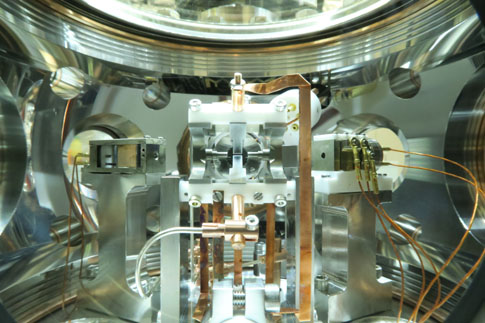
From Hydrogen to Helium+
Highly accurate tests of a theory requires an object that can be both measured
and calculated with extreme precision. A famous example for such a
serendipitous case is two-photon spectroscopy on the
1S-2S transition in
atomic hydrogen. From the theoretical point of view the hydrogen atom is a simple
two body Coulomb system that can be accurately described by bound-state QED. At the
same time it is experimentally well accessible because narrow band cw lasers
are available for the required wavelength (243nm) and as a two-photon
transition it can be excited in an inherently first-order Doppler-free
configuration. This is the basis of a famous track record in physics. Over
more than three decades the experimental uncertainty has improved from
10-7 in the 70ies to better than 10-14 nowadays. Theory has
made remarkable process, too, and the transition frequency can be predicted
to within 10-12. Unfortunately, over the last 20 years progress has
been slowed down both theoretically and experimentally. On the
experimental side it turned out to be very hard to control systematic
uncertainties below a level of 10-14 in an atomic beam experiment.
Theoretical predictions on the other hand require the computation of high
order Feynman diagrams and used to be limited by the uncertainty of the rms
charge radius of the proton. The latter enters theory only as a small
correction but still contributes with the largest uncertainty. What to do?
Linear Paul trap

Helium+
Spectroscopy of the 1s-2s transition in He+ offers a solution for both the experimental and theoretical challenges. As a charged particle, He+ can be stored in the favorable environment of a Paul trap for spectroscopy. The uncertainty of the charge radius of the nucleus is far less problematic - in fact, interesting higher order QED corrections not accessible elsewhere could be determined for the first time! However, a detailed analysis shows that the experiment is not only extremely promising, but also rather challenging for several reasons: Driving the 1s-2s transition requires two XUV photons at 60.8nm where no cw lasers and refractive optics are available and light propagates in vacuum only. The best mirrors at that wavelength reflect only about 40%. Standard cooling and detection schemes fail since no cw laser is available to drive a strong cycling transition from the ground state. But albeit hard, we believe the experiment is feasible.
Strategy
A careful analysis of the excitation dynamics reveals that excitation is accompanied by a significant ionization probability. We therefore plan to operate the ion trap such that the resulting He++ ions remain stored as signature for successfull excitations. We will further co-store an auxillary Be+ ions with the He+ ions that serve as coolant (sympathetic cooling) and for detection (secular excitation). Based on the insight that frequency combs can excite two-photon transitions much like a cw laser of the same average power, we will use a high repetition rate XUV frequency comb for excitation. The XUV comb is generated by high-harmonic generation (HHG) of a NIR frequency comb. About 1µW average power focused to 1µm spot size yields an ionization rate of 1Hz.
Current Members
Fabian Schmid, Akira Ozawa, Johannes Weitenberg, Thomas Udem
Former Members
Byoung-moo Ann, Josue Davila-Rodriguez, Guido Saathoff, Valentin Batteiger, Sebastian Knünz, Maximillian Herrmann
If you are considering joining our team as a Bachelor, Master or PhD student, or as a Postdoc, please email to: Thomas Udem
Further Reading
Fabian Schmid, Johannes Weitenberg, Theodor W. Hänsch, Thomas Udem and Akira Ozawa,
Simple Phase Noise Measurement Scheme for Cavity-stabilized Laser Systems,
Opt. Lett. 44, 2709 (2019)
Byoung-moo Ann, Fabian Schmid, Jonas Krause, Theodor W. Hänsch, Thomas Udem and Akira Ozawa,
Motional Resonances of three-Dimensional dual-Species Coulomb Crystals,
J. Phys. B 52, 035002 (2019)
Akira Ozawa, Josue Davila-Rodriguez, Theodor W. Hänsch and Thomas Udem,
Quantum Zeno Effect assisted Spectroscopy of a single trapped Ion
Scientific Reports, 8, 1064314 (2018)
Thomas Udem, Quantum Electrodynamics and the Proton Size,
Nature Physics, 14, 632 (2018)
Akira Ozawa, Josue Davila-Rodriguez James R. Bounds, Hans A. Schuessler, Theodor W. Hänsch, and Thomas Udem,
Single Ion Fluorescence excited with a single Mode of an UV Frequency Comb,
Nat. Commun. 8, 44 (2017)
Josue Davila-Rodriguez, Akira Ozawa, Theodor W. Hänsch, and Thomas Udem,
Doppler Cooling Trapped Ions with a UV Frequency Comb,
Phys. Rev. Lett. 116, 043002 (2016)
